FINAL HARVESTS
Compressed Gardening Experience
People are so ready to sit at the feet of any long-time gardener to glean words of wisdom. I roll my eyes. Someone who has gardened for ten, twenty, even more years might make the same mistakes every year for that number of years. I, for instance, swung a scythe wrong for 20 years; I may have it right now. Even a wizened gardener who has evaluated and corrected their mistakes has garnered experience only on their own plot of land; these experience may not apply to the differing soils, climates, and resources of other sites.
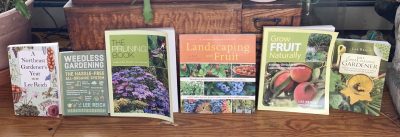
When I began gardening, my agricultural knowledge and experience was nil, zip, niets, rien, nada. But — and this is important — I had easy access to a whole university library devoted solely to agriculture. Hungry to learn, I read a lot. (I also was taking classes in agriculture.) In one year I was able to garner years of, if not actual experience, much of the knowledge that comes with that experience. And my garden showed it.
I’ve now gardened many decades and still gobble up the written word.
All of which is to say that reading reputable sources about gardening can make anyone a much better gardener and do so quicker than by gardening alone. “Reputable” is a key word in the previous sentence. So here’s the, to use the phrase of Magliozzi brothers on the radio show Cartalk, Shameless Commerce Division of this blog: a plug for my books. I stand firmly by anything I’ve written and am open to criticism.
Here’s the book list, all available from the usual sources or, signed, from me through this website (good gift idea, also):
•A Northeast Gardener’s Year: A month by month romp through all things garden-wise, what to do, how to do it, and when to do it.
•The Pruning Book: Plant responses, pruning tools, how to prune just about every plant (indoor, outdoor), and final sections on specialized pruning techniques, such as scything and espalier.
•Weedless Gardening: A four-part system, emulating Mother Nature and based on current agricultural research, that makes for less weeds and healthier plants, along with other benefits such as more efficient use of water and conservation of humus.
•Landscaping with Fruit: Following introductory chapters about designing your landscape is a listing of the best fruits to use for “luscious landscaping” in various regions and how to grow each of these fruiting trees, shrubs, vines, and groundcovers.
•Grow Fruit Naturally: Describes multi-faceted approaches to growing fruits without resorting to toxic sprays, starting with selecting kinds of fruits and varieties and moving on to encouraging natural predators, beefing up the soil, and more.
•The Ever Curious Gardener: Using a Little Natural Science for a Much Better Garden: Knowing some of the science behind what’s going on in the garden can make you an even better gardener; here’s how.
Vegetable Finale
And now, on to some gardening . . .
I’ve said it before and Yogi Berra said it before me, “It ain’t over till it’s over.” Last night’s temperature plummeting to 18°F was still not enough to put the brakes on the vegetable garden. Beneath their covered “tunnels,” arugula, mustard, endive, and napa Chinese cabbage still thrive. Along with mâche and kale, which aren’t under cover, all these greens are looking as perky as ever and, most important, taste better than ever.
Interestingly, temperatures I’ve measured within the tunnels are not that different — actually, not different at all — from temperatures I’ve measured outdoors. But something’s different. The increased humidity under the tunnels is probably at least partially responsible for the fresh tastes and appearances.
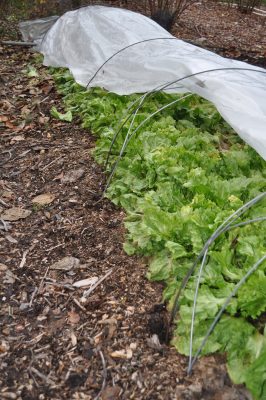
It’s a wonder that these tender, succulent leaves tolerate such temperatures. You’d think the liquid in their cells would freeze and burst the contents to smithereens. That would have been the case if the 18°F had come on suddenly, without any precedents.
Plants aren’t passive players in the garden. Increasingly cold weather and shortening days acclimated these plants to cold. (A month ago, temperatures dropped one night to 16°F.) Plants move water in and out of their cells, as needed, to avoid freezing injury. And increasing concentrations of dissolved minerals and sugars in the cells make the water freeze at lower temperatures. Perhaps that’s one reason why these vegetables taste so good. The tunnels also slow down swings in temperature, giving plants time to move water in and out of their cells and whatever else they do preparing for and recovering from cold.
Too many people, even gardeners(!), consider endive as nothing more than a bitter, green leaf best used as garnish. Reconsider. Given close spacing so that inner leaves of each head blanche from low light along with cool and cold temperatures, and endive takes on a wonderful, rich flavor. 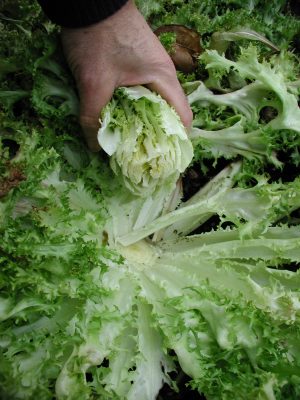 Only the slightest hint of bitterness remains, enough to make the taste more lively — delicious in salads, soups, and sandwiches.
Only the slightest hint of bitterness remains, enough to make the taste more lively — delicious in salads, soups, and sandwiches.
Fruit Finale
The last fruits of the season, Szukis American persimmon, were harvested last week after over a month of eating them. Definitely the easiest fruit I grow. No pruning, no pest control. And definitely one of the tastiest: imagine a dried apricot soaked in water, dipped in honey, then given a dash of spice.

Fruits were very mushy for the final harvests — perfect for a jam. Squeezing a bunch of the fruits in a mesh bag (such as used for women’s “delicates” in a washing machine) pushed out 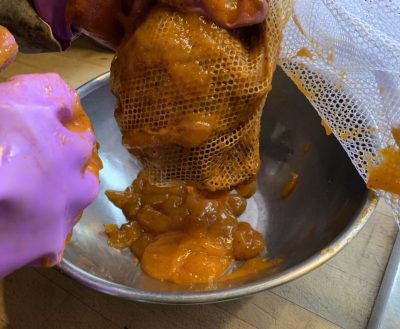 the pulp without seeds. No sweetener needed. Just jar it up and refrigerate (keeps about 2 weeks) or freeze. Delicious.
the pulp without seeds. No sweetener needed. Just jar it up and refrigerate (keeps about 2 weeks) or freeze. Delicious.

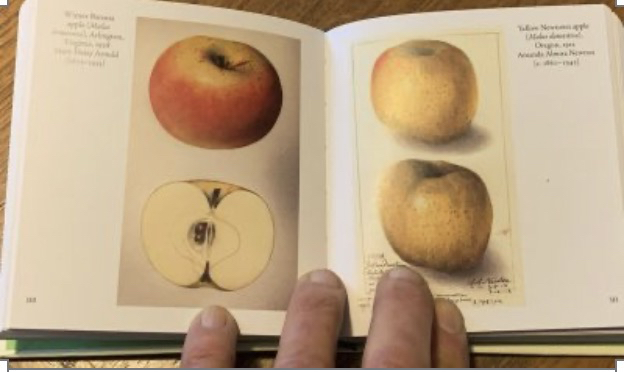
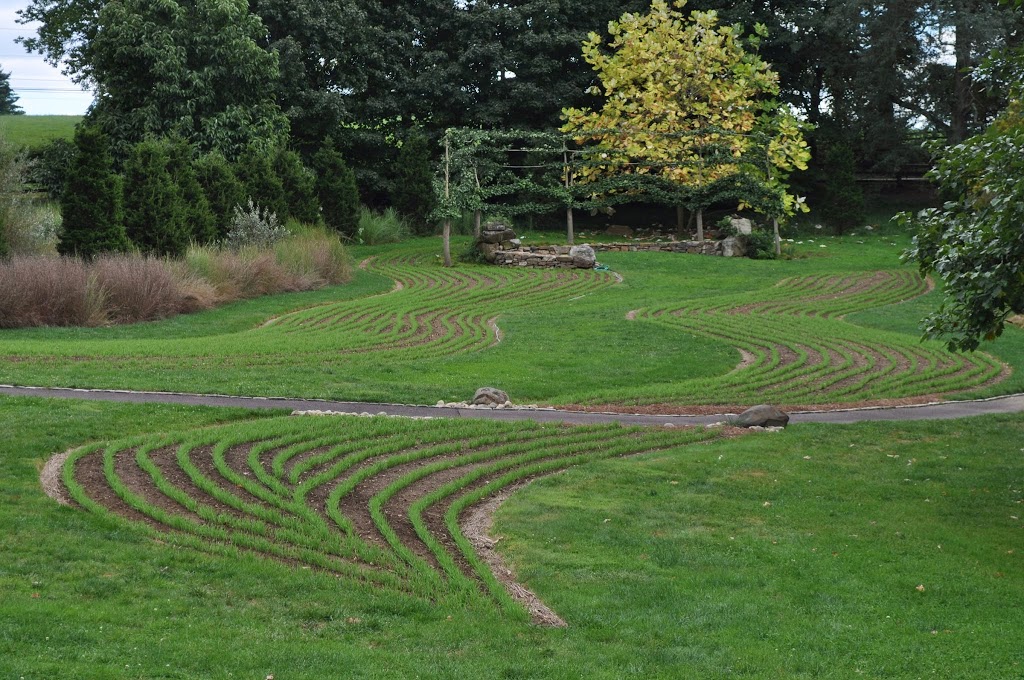


Hello Lee,
I glean words of wisdom from your posts, website, a couple of your books, also a NOFA presentation or two. Thanks for your sharing.
About “something’s different” with the plants under the hoop tunnels surviving the freezing temperatures, and it doesn’t seem to be the temperature. Steve Moore, a Pennsylvania farmer with lots of greenhouse experience, said that it seemed to do with the slow change of temperature inside the tunnel or greenhouse, vs. the more rapid change of temperature happening outside. I found that idea interesting.
True. I think I mentioned that as a contributing factor.
In your book list, you didn’t mention my favorite, “Uncommon Fruits for Every Garden.” I’ve read all your books, but that one I’ve read twice all the way through, and every year I reread the chapters about fruits I am growing (eight fruits so far).
Thanks for the mention. It’s one of my favorites of my books. I didn’t mention it because it’s currently out of print. A publisher will be re-issuing it, in an updated version with a new title and some new content (including some recipes, for example).
Abt 2 weeks ago, I was looking forward to visiting a friend in Woodstock, who had invited me to see and take some of the many persimmons on one of her four trees. Then at the last minute she messaged me that there would be a change of plans; birds had eaten every single last persimmon, so I never did get to view or taste these exotic local delicacies. But my windowsill currently has about a half dozen of the bigger pointier ones, waiting for them to get soft.
Not exotic: American persimmon is a native American fruit (although perhaps not native in Woodstock).
Hi, Lee – Wondering what-all cultivars of persimmon you grow and which ones you think are tastiest and have the best yields? Do some of them not require pollination to fruit? Which nurseries do you recommend from which I can acquire these varieties? I’m looking to plant a few this spring. Thanks!
Where I live, the growing season is relatively short for ripening persimmons. I grow the Mohler and Szukis varieties of American persimmon. Both have excellent flavor. Szukis does not need pollination. Mohler might, but probably not. A web search should show good nursery sources for these trees. The varieties are rare so are unlikely to be offered by a bad nursery.
Thanks, Lee!
Great post. We put up a hoophouse this year and it’s been a mystery to me why the plants thrive when (like you said about your hoops in the garden) the temp is not really all the different sometimes from the outside. Great info to help understand what might be going on. And yes the produce is the sweetest most delicious I’ve ever grown!